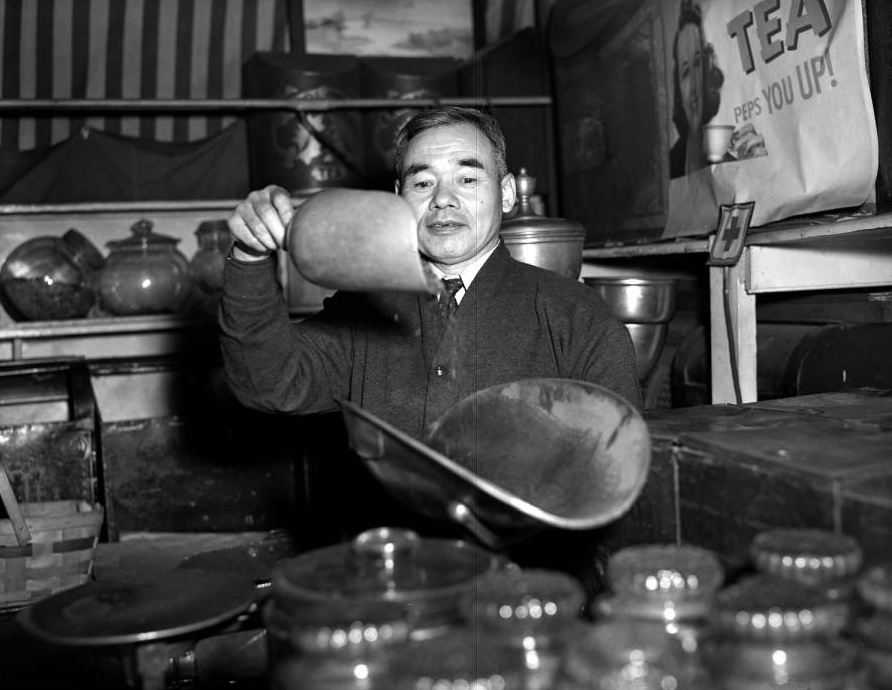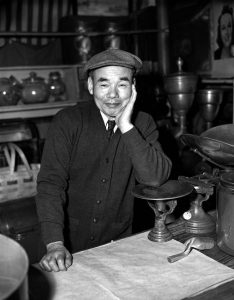
Plan your visit
Our (FREE) parking lot is located on New York Street a ½ block east of West Street. Free parking with admission.
Getting to Know Harry
June 20, 2019

A few years ago, a colleague showed me a photo of an Asian man named Harry Sasaki from the Larry Foster Collection she was working on. The photo was dated April 20, 1943, and thanks to Larry’s notes, we know that Harry Sasaki was at that time a vendor at the City Market in Indianapolis. Two photos exist of Harry with salt-and-pepper hair but of an indeterminable age.

Portrait of Harry Sasaki
Fast forward to April 10, 2019, when I decided to see what information I could find on Harry. I know from experience that researching the Asian community in Indiana is tough. Names are often misspelled, or folks later anglicized their first names. So confirming identities in some public records can be a bit spotty. To my astonishment, after a quick two-hour search, I was able to trace Harry’s life and his three wives in Indiana up until his death.
Harry was born in Japan in 1881 (sometimes shown as 1888). He first arrived in the United States in 1901 and returned in 1905 to sell tea in New York and later Detroit. When he came to Indianapolis around 1912, he lived on Indianapolis’ near eastside and was the proprietor of Japan Tea Company in the Market House, known today as City Market. He initially lived in the Englewood neighborhood and later in the Glenroy Village neighborhood, both on the outskirts Historic Irvington. An Indianapolis Star article in January 1969 states that Harry owned stand No. 19 in the Market House selling tea and coffee since 1912.

News clipping about Harry Sasaki
The 1912 and 1913 City Directory information does not contain a listing for Harry nor Japan Tea Company until 1914, when he is listed at 2808 E. Washington St. The address was next door to what is now Indianapolis’ oldest operating library branch – a Carnegie library built in 1909. That building is now gone and the area serves as a parking lot for the library. By 1915, Harry moves a few blocks away to 425 N. Rural St.. Sometime between 1915 and 1918 Harry marries Della (also listed as Delia or Belle) Sasaki. Della Sasaki was born in Michigan to Canadian and English parents. Did Harry meet Della in Detroit? How did they make their way to Indianapolis? No one knows. Della appears on Harry’s World War I draft registration card in 1917-1918 as his “nearest relative.” On the 1920 census, we find out that Della is seven years older than Harry. She worked with Harry as the secretary-treasurer of Japan Tea Company. By the 1940 U.S. Census, we know they moved and were living at 1921 S. Arlington Ave., where they would both live until their deaths. Della passed away in 1944 at the age of 71.
In 1946, Harry finds love again with widow Edith (Golden) Heppner. She dies in 1956 at the age of the age of 52 or 53. Edith did not have children in her prior marriage. For a short time, Harry seems to live a quiet life, considering the 1940s were a time of anti-Japanese sentiment – a hysteria that was set off in December 1941 after the attack on Pearl Harbor. After the Immigration and Nationality Act of 1952 – or the McCarran-Walter Act – was passed, Harry was able to become a naturalized U.S. citizen and did so in 1954.
In 1961, Harry later marries for the third and last time to widow Edith Elizabeth “Betty” (Lawson) Walker. Betty, like Edith, did not have children in her prior marriage. He would remain with Betty until the time of his death in 1971 at the age of 82. The Japan Tea Company operated at the City Market until 1972, a year after his death. Betty passed away in Seymour in 2000 at the age of 91.
You can see Harry’s photo and learn the history of Indiana’s Asian community in our exhibit Be Heard: Asian Experiences in Indiana open through July 27.








